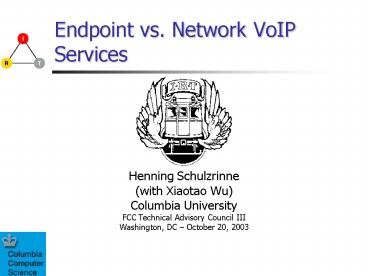Endpoint vs. Network VoIP Services - PowerPoint PPT Presentation
1 / 18
Title:
Endpoint vs. Network VoIP Services
Description:
white and yellow pages. global and corporate. Media services ... distinguish residential / business via application-neutral measures, e.g. ... – PowerPoint PPT presentation
Number of Views:66
Avg rating:3.0/5.0
Title: Endpoint vs. Network VoIP Services
1
Endpoint vs. Network VoIP Services
- Henning Schulzrinne
- (with Xiaotao Wu)
- Columbia University
- FCC Technical Advisory Council III
- Washington, DC October 20, 2003
2
What are services?
- Call routing services ? subset of CLASS services
- name/number translation
- terminal, user mobility
- call forward busy/no answer
- call forward conditional (time-of-day, call
center) - Directory services
- white and yellow pages
- global and corporate
- Media services
- media encoding translation for bandwidth
- media type conversion language, speech-to-text
- media combining conferencing
- Identity services
- identity assertion (Columbia attests that Joe
Smith, an employee, is calling) - identity hiding (agent42_at_anonymizer.com is
calling) - configuration repository
- media preferences
- address book and speed dial
3
PSTN vs. Internet Telephony
Internet Telephony end system
PSTN
Number of lines or pending calls is virtually
unlimited
More (per-user) processing power than most
network servers
Single line, 12 buttons and hook flash to signal
4
PSTN vs. Internet Telephony
PSTN
Signaling Media
Signaling Media
can be far away from either user
Internet Telephone
Signaling
Signaling
Media
5
PSTN vs. VoIP
- PSTN only carriers can get full signaling
functionality (SS7) - UNI vs. NNI signaling
- VoIP same signaling, same functionality
6
Network vs. end system services
- Really two meanings
- services implemented in user agent (instead of
proxy) - services implemented in server run by end user
(instead of carrier) ? - business
- residential
- Variation on old Centrex vs. PBX argument
- except that media routing no longer an issue
- Often, services require or can use both
- e.g., the history of speed dial
- CLASS service translation in CO
- (semi)intelligent end systems locally, possibly
with hotsync to PC - intelligent end system, but network-synchronized
7
End system vs. network trade-offs
8
End system vs. Network services the easier cases
- Network services
- PSTN gateway
- multiplexing gain
- SS7 access
- Backup services
- e.g., no answer from enterprise due to failure
- no permanent connectivity for residential users
- Large-scale conferences for residential users
- bandwidth availability
- End system/user services
- media processing
- distinctive ringing
- programmable services
- user control
- but security maintenance
9
Call routing services
- Outsourcing allows temporarily disconnected end
users - Staged service
carrier proxy
user proxy
personal preferences
basic call routing
10
Identity management
- Identity assertion (notary) services
- best done by larger organization
- server certificates
- name recognition
- recourse
- Anonymity services
- needs to have large user population to provide
effective hiding - Portable services
- high availability and universal reachability
11
Service architectureProgramming language model
12
Service location examples
() with information provided by end system
13
Analogies
- False either/or choice
- See email and web for precedent
- carrier-provided (ISPs)
- basic service
- name portability issues
- enterprise
- provide and manage own infrastructure
- only purchase raw bits
- home user
- albeit actively discouraged
- hosting companies bandwidth service
- shared and dedicated facilities
- but not an ISP in the traditional sense
- service-only companies
- web mail
- mail forwarding
14
The vanishing phone
- Old model
- explicit, user-visible signaling ? dialing,
ringing - small number of phone lines, (mostly) each with
one E.164 identifier - New model
- session initiation from
- IM session ? no dialing and ringing
- game session ? proximity triggers conversation
- event based ? connect if event occurs
- no notion of lines
- teenager (or telemarketer) may have dozens of
chat windows open - some identifiers may make no PSTN calls at all
- from monthly service ? calling card-like
- any number of identifiers
- one per wire or device ? multiple per person
(role-based)
15
Example VoIP embedded in VR
16
The impact of regulations
- Phone (service) companies are not required any
more, but may be useful - dont have (many) email companies, either
- Regulation should not bias technical and business
decisions on in-house vs. out-sourcing - Avoid conflicts of interest for ISPs that provide
phone service - no port blocking except by user request
- traffic neutrality ? provide differentiated
services to all - provide externally routable addresses
- address shortage excuse ? NAT ? difficult to have
inbound connections - distinguish residential / business via
application-neutral measures, e.g., bandwidth or
availability - Goal
- ensure transparent Internet service providers
for added value - encourages service innovation
- encourages service competition
17
Impact of regulations E911
- Traditional notion small number of phone
companies (often, one) do selective routing of
911 calls to PSAPs - PSAP information tightly guarded
- public information, but hard/ to get
- For service competition
- should be able to route to PSAP from my home
proxy - open access to PSAP information
- See my ex-parte filing for details
18
Conclusions
- VoIP enables, but does not force, end point
services - Move service location decision to end user, with
trade-offs in - cost
- control
- availability
- functionality
- technical sophistication needed
- Regulatory framework should
- ensure this user choice
- prevent network operators from stifling service
competition - Consumer protection ? define service rules for
effective monopoly oligopoly providers - goal of transparent (end-to-end) Internet

